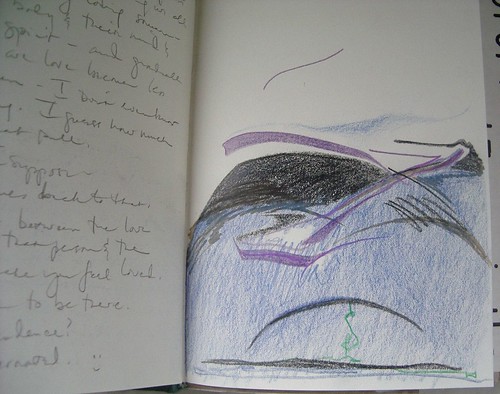May 2010
Vol. 1, No. 5
Vol. 1, No. 5
The Writer’s Journal
 Sitting on the rock just inside the playground, Anna pulled the worn leather journal out of her knapsack, swept the pen away from the paper it had been clipped to, and fervently wrote.
Sitting on the rock just inside the playground, Anna pulled the worn leather journal out of her knapsack, swept the pen away from the paper it had been clipped to, and fervently wrote.She couldn’t help it.
The colors of the children’s clothes –so bright and cheerful- had to be recorded in detail lest she forget the moment she stepped away. The words they spoke, the way their sentences were formed, the giggles and how they erupted, the squeals that bounced gloriously off the metal equipment, even the silence as a child hid beneath the slide a few steps away with a finger pressed to her lips; all these things simply had to make it onto the pages before her.
No, she wasn’t writing about children. Her latest work in progress was very adult in every form and fashion. But who knows? Maybe somewhere in the not-so-distant future there will be the opportunity to write about children and what better to have to refer to than an account written in her own hand?
A writing journal can be about the weather that day, a carefully detailed accounting of what transpired, the emotions the writer experienced, plans for the future, names for an unborn child, even the foods consumed along with their caloric count and the exercise that burned off the added excess. But a writing journal that’s narrowly focused upon the writer him/herself will not lend well to when the writer begins crafting a story. Unless, of course, it’s an autobiography.
Think of your writing journal as a character, setting, location, dialog study. It’s the place to interview your characters outside of the story you’re presently writing, learn more about them, round them out so that when they get back to work at telling their story, writing about little quirks, eccentricities, fashioning them as individuals, it flows naturally. It’s the place to sketch out a landform or blueprint that might be interesting to use in a story. It’s a place to record an overheard conversation so that when writing dialog, you’re able to catch the speech patterns, the innuendos, colloquialisms and breath life into the words
 your characters speak.
your characters speak.Don’t be fooled, though. A writing journal doesn’t have to be just for writing. In fact, when you are selecting your journal, aim for one that does not have lines or intersperses lined pages with completely blank ones. Here you’re able to draw, paste ticket stubs, postcards, cocktail napkins, and whatever else strikes your fancy. Consider your journal as an architect’s desk of sorts where blueprints are being developed, instruments to measure and craft are there for the picking.
Drawing is vital to your journal and to your well-being as a writer. Hitting some speed bumps? Give yourself some time to sketch and loosen up the creative brain. If your descriptions are voluminous, shore it up and try your hand at some logic puzzles. For a buck at the Dollar Store you can buy a decent sized puzzle book (Sudoku, Logic, Crossword, etc.). Simply attach a sheet or two in the journal so that if you’re feeling a bit too creative, working some logic puzzles will help you tighten up your writing and get you back on track in no time.
For resources and other great reads, check out these Web sites about writing journals:
- Keeping a Writer's Journal: 21 Ideas to Keep You Writing
- Invent a persona for your journal -- a character who is employed as a journal writer for you, whose job it is to make entries on a schedule you propose, ...
- www.writing-world.com/creative/journal.shtml
- On Keeping a Writer's Journal
- One piece of advice, given to writers so often it's almost a cliché, is to keep a journal. What is less often covered is what to write in those journals and ...
- www.fmwriters.com/Visionback/Issue10/advjournal.htm
- How to Keep a Writer's Journal | eHow.com
- How to Keep a Writer's Journal. Writers, like other creative people, should always keep a journal on hand to write down those ideas that occur to them while ...
- www.ehow.com › Arts & Entertainment › Books › Authors
- Creating a Writer's Notebook: An Invaluable Tool for Your Writing Life
- No matter where you are in your writing journey, a writer's notebook is an invaluable tool, every step of the way.
- www.creativity-portal.com
May Newsletter Home
- Editor
Interview: Erin Brown - Article:
Pitching Your Novel
Article: Writer's Journal - Guest Author: MaryRose Lovgren - Guest Author: Donna Hole
Regular Feature: Get It /Write/ Right - Regular Feature: Writing Prompts
Calendar of Events - Call for Submissions - Feedback - Previous Issues - Resources
Article: Writer's Journal - Guest Author: MaryRose Lovgren - Guest Author: Donna Hole
Regular Feature: Get It /Write/ Right - Regular Feature: Writing Prompts
Calendar of Events - Call for Submissions - Feedback - Previous Issues - Resources

0 comments:
Post a Comment